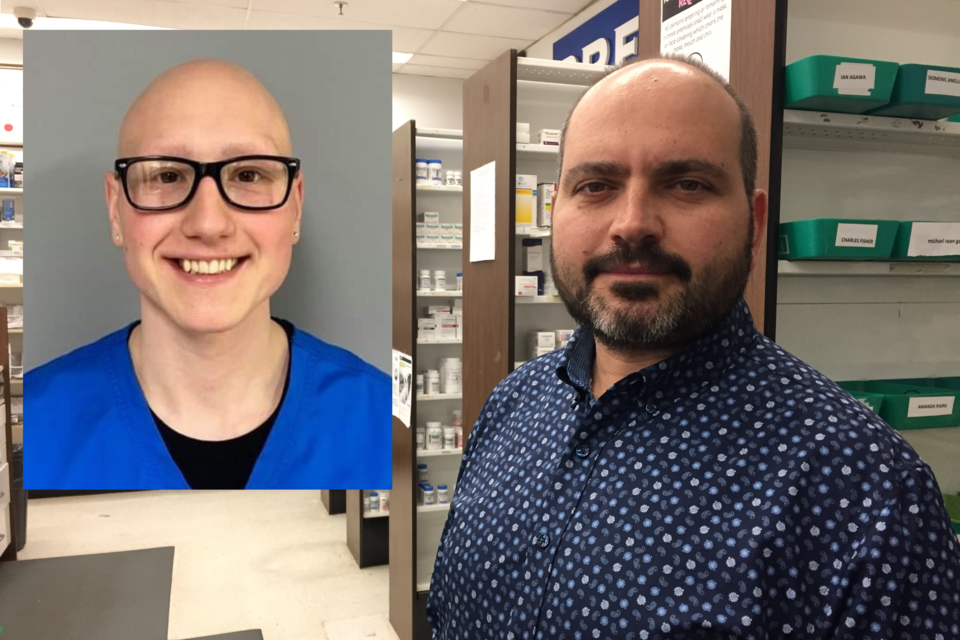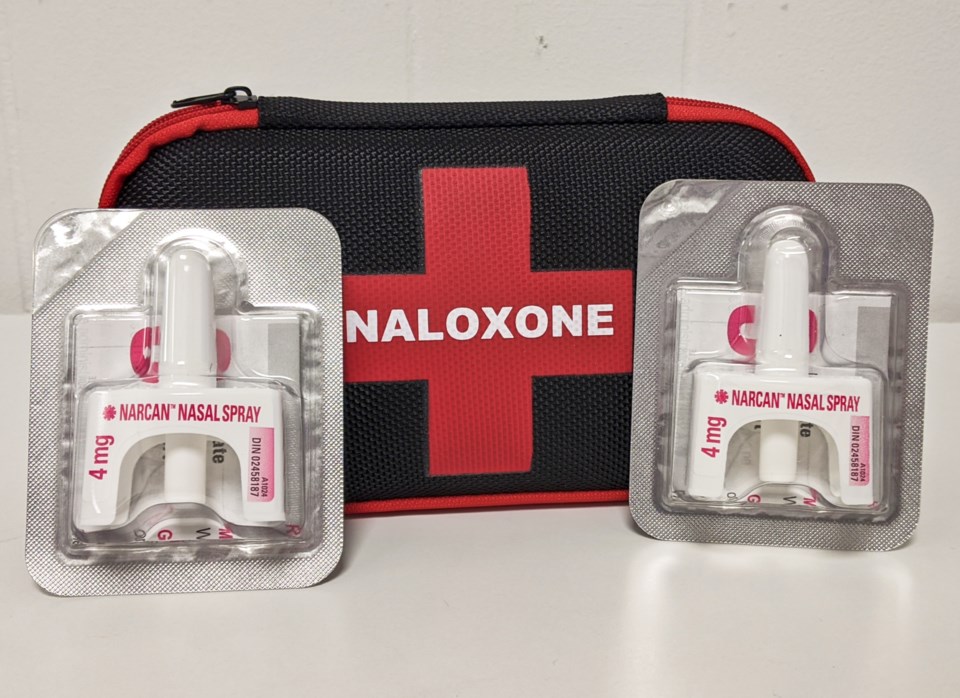For many months, I've never left home without a naloxone kit.
No, I don't use opioids.
But I work very irregular hours and I'm often out and about very late at night.
I see stuff on our downtown streets and back alleys that many of us don't get to see.
I carry naloxone because I feel more comfortable knowing that, when the opportunity comes to administer this life-saving antidote, I'll be able to do so.
I remember being offered the choice between an injectable naloxone kit and the nasal spray version.
I chose the nasal kit.
I really couldn't see myself, with absolutely no lived experience, stabbing a syringe into someone's shoulder or thigh muscle.
Nope. That's definitely not for me!
So when Frank Perna, pharmacist and co-owner of Station Mall IDA Drug Mart, told me last week about the young man he helped in the parking lot beside the Galaxy Cineplex, I definitely related to his story.
Perna is afraid of needles.
Really afraid.
But when he heard about the man overdosing in the parking lot, he looked at the nasal kit and the injectable, and chose the needle because he understood it to be somewhat more effective.
As he sprinted to help the young man, all he could think about was how he was going to overcome his fear and do what had to be done.
You'd think pharmacy employees would have considerable experience with administering naloxone, the miracle drug that temporarily reverses drug overdoses.
Not so.
In fact, it's quite rare for pharmacies to have to actually inject someone with naloxone.
Bottom line: people don't shoot up at drug stores.
And they don't hang out there after shooting up.
So your local pharmacist is probably no more experienced than you or I when called on to stick someone with a needle full of naloxone.
Frank Perna lucked out.
He'd completely forgotten he had a recently graduated registered nurse, Julian Semczyszyn, on duty that day to give tuberculosis shots.
Semczyszyn had also heard about the OD'd man in the parking lot, and was running to the scene right behind Perna.
Giving needles is second nature to nurses.
So Semczyszyn did the job.
Journalists are odd ducks: I admit to sleeping with an emergency scanner.
We don't write about medical calls, but I'm aware every time Fire Services responds to one.
If you've ever called 911 because a loved one has overdosed, know that every time I hear the dispatcher say the words 'VSA' (vital signs absent) and 'probable overdose,' I say a little prayer before any emergency responder arrives.
It's far from unusual for naloxone to be used in Sault Ste. Marie.
But as I was collecting the stories from Perna and Semczyszyn, I felt there was a unusual power to their first-hand account.
I'd been trained to administer naloxone, but still, I learned a lot from their experience.
I wrote a fast story in traditional Canadian Press style.
It was esssentially done in time for the evening deadline.
But I felt this was one of those 'teachable moments' that presented a golden opportunity to educate people about naloxone.
So I called the night editor and asked for more time to rewrite the story as narrative journalism – creative nonfiction conveying carefully researched biomedical information in a more interesting way.
I spent most of the night doing that.
I'm thinking it might have struck a chord.
When I checked Semczyszyn's Facebook profile after the article appeared, I found he'd received endless pages of congratulatory notes for his rapid response and clear thinking, many from people connected to his years in Sault College's nursing program.
"One of our new grads!!! So proud of him!!!" wrote Lori Matthews.
"Wow, I got goose bumps reading this! Way to go Julian Semczyszyn!!! So proud of you," added Melissa Beattie.
"So proud of you Julian Semczyszyn!! Complete reassurance that you are in the right field. Keep saving lives," said Carley Gassi.
"I would personally like to thank everyone for the outpouring of love and kind words," Senczyszyn responded.
"I would also like to give proper recognition to Frank Perna who, even with a fear of needles, ran out with a naloxone kit in hand. In my opinion, putting your fears aside to help someone is the true mark of a hero. Thank you all!!"
Here is the original story, as it ran last week:
 A pharmacist and a nurse stepped in to help save a man in medical distress on Tuesday near Galaxy Cinemas in the Station Mall.
A pharmacist and a nurse stepped in to help save a man in medical distress on Tuesday near Galaxy Cinemas in the Station Mall. 'He was gone.' Man barely breathing outside Station Mall brought back by naloxone injection
Two Good Samaritans, one with a morbid fear of needles, raced yesterday to help a young man near Galaxy Cinemas
Sprinting yesterday to the parking lot beside Galaxy Cinemas, Frank Perna could think only of one thing: the naloxone kit in his hand with its stabby little syringe.
Naloxone is the opioid antidote that temporarily reverses potentially deadly drug overdoses.
It's available in both nasal sprays and injectable form.
Perna, pharmacist and co-owner of Station Mall IDA Drug Mart, had just been advised that a young man, twenty-something, was lying in the middle of the parking lot with a presumed overdose.
Perna grabbed an injectable naloxone kit because he understood it to be more effective than the spray.
But he's trypanophobic, so all the pharmacist could think about was the slender-pointed syringe in his hand, and how he had to overcome his morbid fear of needles and somehow stab the thing into the shoulder or thigh muscle of the blue-lipped man motionless on the pavement.
"The whole time that I'm running out there, I'm petrified of needles," Perna told SooToday.
Fortunately, help was just a few paces behind him.
In the rush to get to the parking lot, the pharmacist had completely forgotten he had a nurse on duty that day, doing tuberculosis testing.
That nurse, Julian Semczyszyn, had already heard a technician saying someone was overdosing in the parking lot.
"As soon as I heard that, I ran . . . as fast as I could to the person in the parking lot," Semczyszyn said.
"When I got there, the man was unconscious and surrounded by a small group of people. I asked everyone to step back and to call the ambulance."
"I forgot that the nurse was here," Perna admits.
"He chased after me. I gave him the naloxone."
"By that time there was security there and a couple of other people. Somebody had taken a blanket out of their car and put it over him because it was quite cold, especially near the waterfront."
"The guy had no vitals. You could tell he had thrown up and stuff like that. He was on his side. He wasn't breathing," Perna recalled.
His training as a registered nurse, however, enabled Semczyszyn to pick up some faint signs that the man on the ground was still alive.
"His pulse was alarmingly low and he was barely breathing. So I administered the naloxone injection as fast as I could. He was coming in and out of consciousness so I stayed with him and did everything I could to keep him awake."
"I kept checking his pulse and it began to normalize. The fire department showed up first and began to run his vitals."
"At this time, I kept shaking him and calling his name to that he would keep breathing and keep his eyes open," Semczyszyn said.
"After about four minutes the man regained consciousness and was able to get up on his knees and soon after, his feet."
"The ambulance arrived shortly after and I gave them a report on the situation and handed the gentleman off to their care."
Adds Perna: "He just snapped out of it. Stood up and wanted to walk away.""This guy, his facial features were bluish-purplish. He was gone. It took five or six minutes. Slowly but surely you could see him come back to the surface. It was just like you were hypnotized and the hypnotist snaps his fingers. He just stood up like nothing happened."
"He just woke up like out of a bad dream. He just stood up and wanted to know what happened."
Perna commended Semczyszyn for acting swiftly and keeping a cool head through the emergency.
"We have a couple of nurses on staff here at the IDAs. He didn't second-guess. He just went out there and did his thing. It was cold out. He didn't have a jacket. He was very calm to the patient. He took over the scene. If it wasn't for him, they would have been bringing him on a slab."
This harrowing rescue comes the same day Algoma Public Health revealed that the Sault and other parts of the district are on track to see between 52 and 60 opioid-related deaths this year. We have already matched the previous record of 26, which was set in 2018.
Naloxone kits, Perna said, are available without charge from participating drug stores.
"You don't even need a health card any more. We will always give a naloxone kit, no questions asked. We don't pass judgment. We give it and we just make sure that they know how to use it properly."
"Naloxone takes between two and five minutes to work and can last in the body for 20 to 90 minutes," says the Algoma Public Health's web site.
"Naloxone kits do not replace the need for emergency services; calling 911 is still necessary. If you suspect someone is overdosing, and you are unsure of what they have taken, you will do no harm by giving naloxone. Side effects are extremely rare."
"Calling 911 is critical – once the naloxone wears off, the person is still at risk of overdosing again."
In Sault Ste. Marie, naloxone can also be obtained from Algoma Public Health or from participating community agencies.
